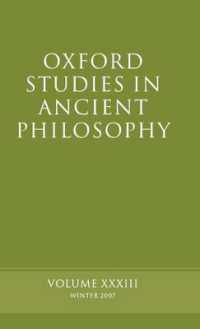- ホーム
- > 洋書
- > 英文書
- > History / World
Full Description
In 221 BCE, the Qin state conquered its neighbours and created the first unified Chinese empire in history. So began the imperial era, where dynasties claiming divine assent ruled for more than 2,000 years.
Borders shifted and emperors struggled to exert control over every region of their diverse territories. Elites held that they were inheritors of a rich, pre-imperial culture, while their society produced world-changing inventions such as the compass, printing, gunpowder and the gun. And imperial China itself was altered as it came into contact with others through trade, exploration and war.
For anyone curious about this fascinating period, Peter Lorge introduces imperial China's major ruling dynasties, religions, arts, thinkers, inventions, military advancements, economic developments and historians.
Contents
Map
A Timeline of the Dynasties of Imperial China
Introduction
Before the Imperial Age
Imperial China
Master Kong, the Ru, and Confucius
Language
Conclusion
1 Foundations
The Imperial State
Law and Morality in Reality
Conclusion
2 Dynasties
Similarities
Differences
The Other Dynasties
Conclusion
3 Borders
Geography
Macroregions
Localities
Conclusion
4 War and the Military
Military Technology, Society, and Politics
Organization
Guns
Military Thought
Conclusion
5 Discovery
The Four Great Inventions
Other Technology
Contact and Exploration
Conclusion
6 Religions
Popular Religion
Ruism (Confucianism)
Buddhism
Daoism
Conclusion
7 The Imperial Economy
The State
Money
Markets
Conclusion
8 The Arts: Literature, Calligraphy, Painting, and Architecture
Literature
Poetry
Prose
Calligraphy
Painting
Architecture
Conclusion
9 Popular Arts and Culture
Decorative Arts
Gardens
Public Performance and Theatre
Popular Literature
Conclusion
10 Constructing China Through History
Sima Qian (c.145/135-c.86 BCE) and The Records of the Grand Historian
Ban Gu (32-92) and The History of the Han (Hanshu)
History Writing in the Tang Dynasty
History Writing in the Song Dynasty
Conclusion
11 The End of Imperial China?
Imperial History
Diversity
Unity
Conclusion
Acknowledgments
Further Reading
Index








